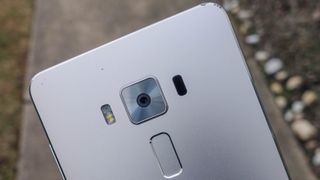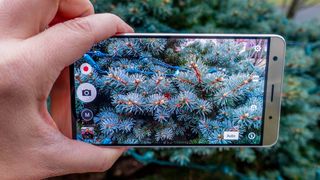Why you can trust TechRadar
Camera
- 23MP sensor takes okay outdoor photos in proper light
- Slow and filled with noise in anything that resembles lowlight
- Over 20 different camera modes and a good selfie snapper
Asus paid more attention to the Zenfone 3 Deluxe camera, and it cranks up the megapixels with a 23MP Sony IMX318 sensor it dubs "PixelMaster 3.0." Sounds more like a really bad 90s AOL Instant Messenger screen name for a pompous camera guru.
That translates to a f/2.0 lens that’s supposed to take 0.03 seconds to autofocus. There's optical image stabilization onboard for shaky hands and a dual tone LED flash for night shots.

Don't let the high megapixel count fool you. The Samsung Galaxy S7 and Galaxy S7 Edge cameras is still the best in the biz right now and it's only 12MP. It's all about the quality of the sensor and post-processing, especially when it comes to low-light photos.
In fact, though the Zenfone 3 Deluxe nearly doubles Samsung’s megapixels, it’s not even close to being on par to the Galaxy S7 camera.
Outdoor photos in ample sunlight are good enough and, based on that alone, we would have recommended this as a reliable Android camera. But it turns into something of a smartphone werewolf after sunset and indoors without proper light.

Photos in any sort of shade exhibit too much shadow and everything lacks detail. That’s a big problem when high-end phones take better photos and cheap Android phones do too.
Even with laser, phase detection and continuous auto-focus employed, the camera is too slow to take photos in lowlight, and that’s a big headache. And you can forget about capturing moving subjects. They’re already gone or moving streaks in low-light.
To its credit, Asus’s camera is bursting with modes, including a comprehensive manual mode with controls for adjusting the focus, white balance, shutter speed and ISO.
Almost all of the other modes try to compensate for fidgety people with good ideas: All Smiles, Children, and Time Rewind are a mix of facial detection and picking the best burst photo.
Our favorite part is that the kid-face-detecting Children mode includes sound includes trumpet and animal noise sound effects to get kids to look at the camera. It’s odd, but effective.
There are actually 20 camera modes in total, including HDR Pro, Beautification, Depth of Field, Super Resolution and GIF Animation. These would be helpful is the camera always worked well.
Zenfone 3 Deluxe can shoot 4K video at 30fps and it’s steady enough (but not as good as the Google Pixel XL) by mixing optical image stabilization (OIS) and software-driven electronic image stabilization (EIS). Time lapse and slow motion are here at low resolutions.
The front-facing camera is 8MP and it takes better-than-average selfie photos. Just be sure to turn off the alien-looking beauty mode that’s enabled by default to get a more realistic shot.
Battery life
- Lasts longer than other phones with a 3,000mAh battery
- Owes much of its longevity to a lower-res screen and software
- Awfully named ‘BootMaster Fast Charging’ charges it rather quickly
The all-day-plus battery life also withstood our lab tests, in which we played a looped 90 minute HD video at full charge. It ended up draining just 13%, on par with the Samsung Galaxy S7.
The Asus Zenfone 3 Deluxe battery has two things going for it: its low-resolution screen and its (sometimes too) aggressive battery-saving tweaks when you’re down to your last precious 10%.
There’s a positive trade-off for having your phone fire up fewer pixels in a 1080p display, and the Zenfone 3 Deluxe Super AMOLED screen looks just fine; small pixel loss, huge battery gain.
With Qualcomm’s Snapdragon 820 onboard, the battery benefits from Quick Charge 3.0, which means it can quickly fill back up rather quickly with a compatible charger.
There’s an Asus fast charger included and we got the same numbers using an extra Samsung Galaxy Note 7 charger (hey, it’s not ever using it again) that turned out to be just as compatible: 20% in 15 minutes, 47% in 30 minutes and 70% in 45 minutes. It took 89 minutes to reach 100%.
Perhaps the only thing we can’t get behind about the battery and charging is the silly name for Asus’s charging standard: ‘BootMaster’ Fast Charging. Every manufacturer has their own name for fast charging (even if they’re based on the same tech) and it sounds like another bad screen name from yesteryear.


